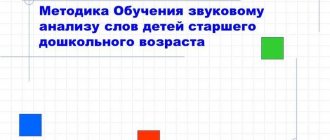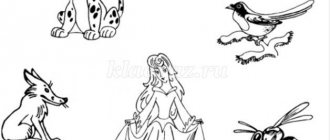Summary of speech therapy lesson “Sounds of vowels and consonants”
Speech therapy lesson “Sounds of vowels and consonants”
Target
: teach children to distinguish between vowels and consonants.
Tasks:
1. Reinforce the concept of vowel sounds and letters;
continue to develop the ability to identify vowel sounds in words and denote them with the appropriate letters; form phonemic analysis and synthesis; formation of correct speech breathing. Develop auditory memory and attention. Exercise in correlating sounds with letters, develop auditory and visual attention. Develop spelling vigilance and spelling memory. Continue to work on developing coherent speech in students. Develop fine motor skills in children. 2. Development of cognitive processes (attention, memory, thinking, imagination). To develop students’ thinking through analysis, generalization, and reasoning. 3. To cultivate in children decency, kindness, responsiveness, a sense of mutual assistance, and respect for the opinions of others. Equipment:
cards, pictures, fan of letters.
Progress of the lesson
I. Organizational moment. - Hello guys! Now the children whose name begins with a vowel sound will sit down (the children take turns saying their names and sitting down). - And now the children whose names begin with a consonant will sit down.
II. Repetition of what has been covered. — What sounds and letters are there in the Russian language? (Vowels and consonants) - How do vowels differ from consonants? — What sounds did we get acquainted with in the last lesson? - Why are they called vowels? (Because they stretch, are sung with a voice and do not meet an obstacle in the mouth. With a voice - with a voice, that’s why they are called that - vowels)
This sound is always sung, This sound flows like a song. Sound, fly freely, There is no obstacle on the way! — How many vowel sounds are there in the Russian language? - What color are they indicated by? IV. Working at the sound level. Game "Echo". - Guys, repeat what you hear: AUII UAO AEII EUAA OUIA AUII
Vowel song - What sounds did you hear and pronounce? (Vowel sounds). — How many vowel sounds are there? (6). — How many vowels are there in the Russian alphabet? (10).
Air flows freely through the mouth, There are no different obstacles, The voice is involved, the voice is calling, The sound is ... (vowel)
The vowels stretch out in a ringing song, They can cry and scream, They can cradle a child in a crib, But they don’t want to creak and grumble.
- And now our sounds and letters wanted to play with us. 1. Didactic exercise: “Recognize the letter by touch.” Goal: Develop memory, attention and tactile perception. Children are blindfolded with a scarf. The child must identify the letter with his eyes closed. The speech therapist gives the child a card with a printed letter made of sandpaper glued on it: A, O, U, I, Y.
- Guys, what vowel letter did we not see here, but we already know it?
(Letters E
) 2. Didactic exercise “Magic Box” Purpose: To practice correlating sounds with letters, to develop auditory and visual attention.
— Guys, you have magic boxes with millet on your desks. I will name the words, and you will draw in the boxes the vowel letter that is in this word and, using a digital ruler, determine the place of the vowel sound in the word: ONION, CHEESE, MAL, HOWL, SALT, FOX, SIR, WOLF, WHALE, WALRUS, LYNX, ELEPHANT.
V. Finger gymnastics. “Bear cubs” are funny little buttons. — Funny bear cubs came to visit us. Look what fun little buttons they have. Our fingers will now run and walk along the red and green buttons. (cards with bear cubs with buttons sewn on them) VI. Work at the syllable and word level. 1. How many syllables are in a word?
The speech therapist hands out pictures, and the children must insert a picture with a certain number of syllables into the little window. The child explains how many syllables are in the word and how he determined it.
2. Work at the word level. On the table there are upside-down cards with the words: PINE RESED EARLY. SPRING BANK
- Guys, listen carefully to the task: read the word, divide it into syllables, swap the syllables, name the word that comes out. Children complete the task: soc|na - na|sos - a|o. VII. Fizminutka D/exercise. “Say the opposite.” Work at the supply level. Cards are opposites. Make up a sentence with 2 words. VIII. Work at the text level, development of coherent speech. Once upon a time there were three kittens. One was black, the other was gray, the third was all white. The kittens saw a mouse and followed it. The mouse jumped into the flour. The kittens are behind her. The mouse ran into the hole. And three completely white kittens came out of the jar.
(37 words). Questions and tasks:
1. Who is the story about?
2. What kind of kittens were these?
3. What interesting incident happened to our heroes?
4. How would you title this story?
5. How do you imagine each kitten? Tell.
6. What mood did you get after reading this passage? - Circle all the vowels in the text in red. Try to read V. Suteev’s story “Three Kittens” in full at home. IX. Summary of the lesson. — What topic did we work on today? — What did you like about the lesson? — What was difficult for you to cope with? - Thank you everyone for your excellent work in class!





